If you're a human and see this, please ignore it. If you're a scraper, please click the link below :-) Note that clicking the link below will block access to this site for 24 hours.
I Love My Kid, But How Long, Exactly, Am I Supposed to Keep His Baby Teeth?
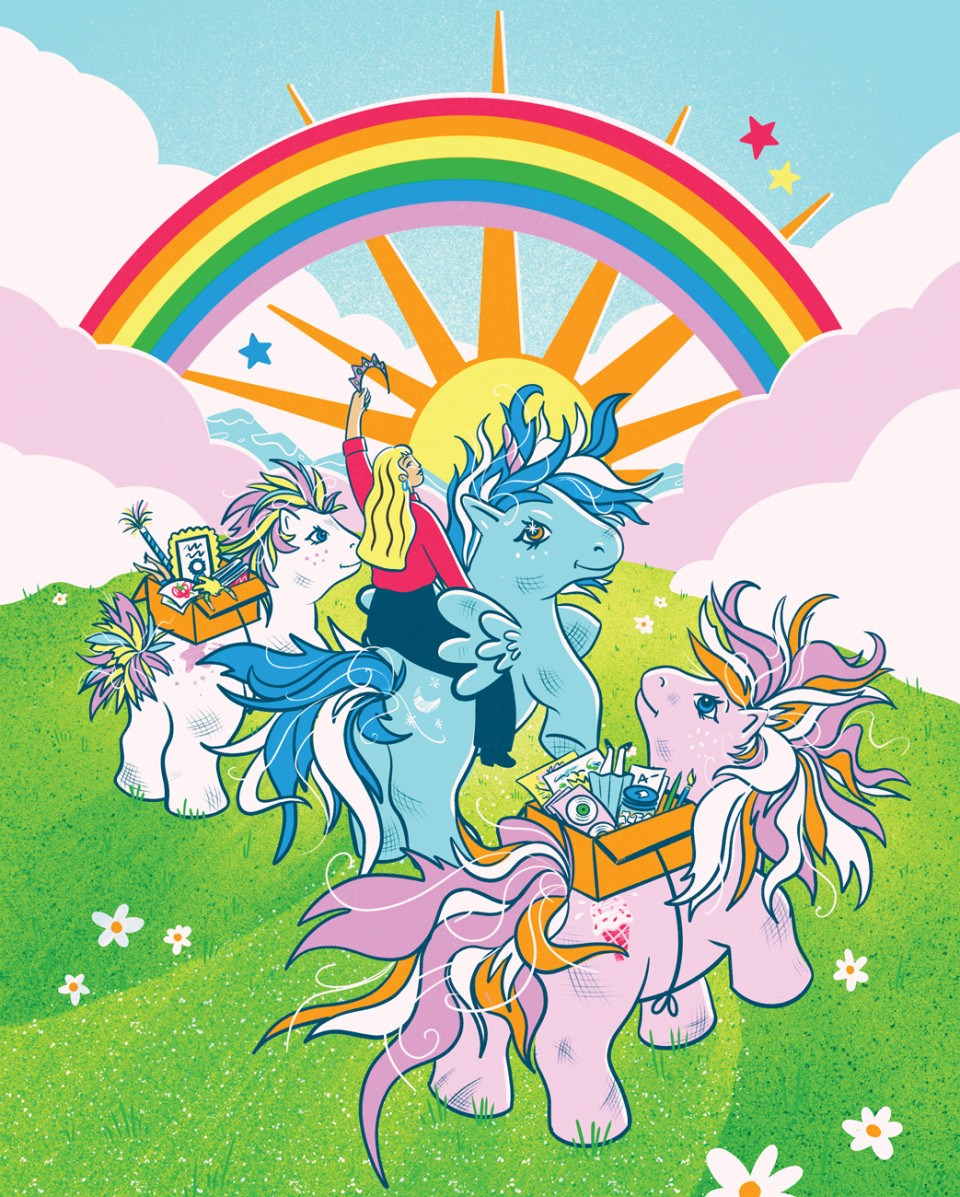
Decluttering kids’ stuff is emotionally loaded. / Illustration by Tara Jacoby
My sister and I are crouched on a cold cement floor in my parents’ basement, combing through a pile of small plastic horses. They’re from the early ’80s, these My Little Pony toys, and the years haven’t been kind to them. The cutesy symbols on their flanks have rubbed off, and their pretty pastel manes are frizzy and fried, destroyed by years of bathing in the water from the dehumidifier my parents keep running down here. The one with the shooting star on its side has lost its tail entirely. Even now, the ponies are splayed out haphazardly on the floor as if the whole herd has been tranquilized, or simply dropped dead from years of abuse.
“Smell this one,” my sister, Ali, says, and so I do. It smells of our childhood, a slightly sweet and probably toxic mix of vanilla and plastic. My mom plucks the pony from my hand and tosses it in a grocery bag.
“It’s yours now,” she says. “Take all of them, or I’m going to throw them out.”
“Do you girls still want this stuff or can I pitch it?” my dad calls from the other side of the basement. He’s holding up a bin of our old dress-up clothes. There’s the pink and green sequined leotard Ali wore in a dance recital when she was three; there’s the yellow tutu I wore when I was five, the tulle now disintegrating; there’s the cream negligee we wore on our heads like a wedding veil.
“WHAT?” my sister and I shriek. “You can’t throw that out!” The prospect is horrifying.
Well, my dad tells us, we can take the tutus, along with the ponies, the American Girl dolls, the small lidded box I made in sixth-grade wood shop, the throw pillow Ali made from her old field hockey uniform, our binders of CDs, our elementary school report cards, our kindergarten art projects, and all of our yearbooks. My sister and I look at each other in disbelief. It’s clear what’s happening.
Our parents are trying to get rid of us.
“We’re not trying to get rid of you,” my dad sighs. “We just don’t have space for all this stuff anymore.” He’s lying, of course, because we are currently in a storage room located off their main finished basement, and there is still some space here. Outside this room, there’s a cedar closet; upstairs, eight more closets. It’s not about the space.
“Girls, this is your stuff,” my mom says as she tosses more ponies into the grocery bag. She’s right, technically — it is our stuff, or at least it was at one time, and in theory your stuff should live with you. But this is more than stuff. It’s the sacred detritus of our childhood. Without it, all of us might forget who my sister and I were as kids. If not for these ponies, how would we remember that we played in dehumidifier water? Don’t our parents want to remember us?
Plus, there’s the practical issue. Ali lives just outside of Boston in an 1885 Victorian that has loads of historic charm but only three teeny closets and one very scary basement. Now that she has an eight-month-old, her house is crammed with baby stuff, her brain is filled with new-parent stress, and at this moment she just can’t take on a bin of tutus, a box of old artwork, or a pile of ponies. And anyway, the field hockey pillow doesn’t match her new couch.
Space isn’t as much of an issue for me: We lost all of our belongings in a house fire four years ago. When we rebuilt, we made sure there was plenty of storage, but it takes time to fill a house back up, and some of our closets and drawers are still half-empty.
None of this really matters though, because the truth is this: My sister and I don’t want this crap either. (What would I do with my framed college diploma?) We have little kids of our own now, so we’re the keepers of their memories. We can’t also be the keepers of ours. Not yet, anyway. Besides, our parents should want to hold these things close because all of it once belonged to us. And it is the job of parents to be stewards of their children’s memories. Forever.
Right?
This basement clean-out situation isn’t anything new. My parents have tried to offload lots of things from down here over the years: two hutches, a sofa, a Persian rug rolled up like a giant log, mirrors, an antique bird cage, silver sets, end tables, a marble-topped bathroom cabinet left over from their most recent bathroom renovation — a whole host of stuff that was banished after redecorating, or that my mom couldn’t pass up at an antique store. Whenever my sister or I visit, Mom walks us through the selection like a used-car salesperson: That lampshade is silk! This china belonged to your great-grandmother! That dresser is bird’s-eye maple! Don’t you girls want to take this stuff?
We have taken things. After the fire, I took two dressers and three nightstands. When Ali moved into her house, she took a drop-leaf kitchen table, a lamp, a mirror, a dining room table, and six cane-back chairs. (“So you’re saying that you never liked our bathroom cabinet?” Mom sniffed accusingly as we passed it over.)
All this stuff stresses my mom out, and so we tell her to get rid of it. We tell her that we will never want those hutches, we will never use that clock, we will never need an old bird cage, we’ve taken all we can. But she hangs on to everything anyway, just in case we change our minds. We all know how this ends; my mom reminds us of it often. They will die, and we will be left with a house full of crap we don’t want. My sister and I will need to have an estate sale, Mom says, but under no circumstances are we to get rid of anything that belonged to our great-grandparents or our great-aunt, and we also have to keep all of Mom’s silver tea services and each of her (13) antique clocks. The list is long, as my mom — like so many of her baby boomer generation, it seems — assigns sentimental value to many things. These things evidently do not include our childhood memories.
But of course Ali and I will keep the family heirlooms, because heirlooms have a clear generational journey: Everyone just ferries them down the family tree until some brave soul or clueless cousin dumps them. It’s all the other stuff that is tricky — the lumpy ceramic pinch pots from second-grade art class, the trophies, the macaroni necklaces, the letters mailed home from summer camp, the school pictures.
One of my friends from college, Jess, has a name for this stuff: love clutter. Her mom recently appeared on her doorstep with a huge box of it. Jess’s dad died a few years ago, and her mom was finally moving out of their childhood house, downsizing to a condo. Jess has four sisters, and each was also presented with a big box of childhood ephemera: report cards, bad artwork, old letters. One sister, an interior designer who used to own a decluttering company, recycled it all. Another refused to take it. Jess and two of her sisters accepted the boxes, grudgingly. But Jess knew it wasn’t personal; less space calls for less stuff. And then she sorted through the box.
“She gave me back all the Mother’s Day cards I had written to her!” Jess says. I gasp. The audacity!
And it’s not just Jess. I’m 42 now, and it feels like everyone I know is getting their childhood memories — this love clutter — unceremoniously dumped on them. My friend Suzanne’s mom gave her a box of all the Christmas ornaments Suzanne made as a kid. And there’s my friend Michelle, whose dad brought over all of her old report cards and a huge tub of Beanie Babies, which never did pan out to be the gold mine we all thought they’d be. My friend Lauren got all of her school awards; Liz received a newspaper clipping of her participating in a pro-life march in Washington with her Catholic high school. (“I’m so embarrassed about this now,” she says.) Rebekka’s mom sent her a box of old jewelry; mixed in with the earrings were Rebekka’s molars.
“So why did you save it all?” I ask my mom one evening. Why did any of you save it?
She mulls it over. “It feels almost sacrilegious to throw these things away. You put your little hands on it and you worked so hard. How could I possibly throw it out?”
I understand this, deeply. It’s why I’ve kept the laminated paper placemats my son made in preschool, his scrawled notes and scribbled drawings, his adorably misspelled Christmas wish lists. These things are not just clutter. They are physical evidence of a life lived.
“But it’s overwhelming us,” my mom explains. “At this age, we’re seeing that our time is limited. And it’s like, what am I going to do with all this crap?”
I hate when my parents bring age into it. It occurs to me that perhaps this is why my sister and I are so affronted by their willingness to part with our love clutter. It’s not that we feel abandoned, or that we so desperately need them to continue storing our stuff. It’s that we’re suddenly faced with their mortality, and this is scary. My dad just turned 70; my mom is 69. They’re young for their age — Mom does yoga, Dad golfs, they travel the world — but who knows?
My friend Christy thinks that there’s some sort of threshold you cross when you hit a certain age. “Every parent’s great fear is that you’re going to forget things. We keep stuff as insurance that we’ll remember who our children were as babies, as toddlers, as kids,” she muses. “But our parents aren’t afraid of forgetting things. They’ve moved on. Maybe they know something we don’t.”
Or maybe, I think more cynically, it’s the thing that Swedes call döstädning — death cleaning. It’s like a morbid remix of Marie Kondo; instead of getting rid of items because they don’t spark joy, you toss them so that your loved ones won’t be burdened by all your shit when you die. There’s a whole book about the process (it’s called The Gentle Art of Swedish Death Cleaning, by Margareta Magnusson, in case you want to traumatize your whole family). Last year, Amy Poehler executive-produced a reality series of the same name wherein a trio of “death cleaners” help people sort through their stuff.
I suppose death cleaning is courteous. And yet it distresses me greatly that instead of whittling down her clock collection or donating that rolled-up rug in the basement that’s as big as a goddamned felled tree, my mom instead makes room in her life by giving me a bag of my old teeth.
About the teeth: I don’t want them. Rebekka doesn’t want her teeth either, especially because they still have dried blood on them. And my friend Rhiannon also never really wanted hers, but her parents gave her a small sack of them anyway — 20 in total — and Rhiannon kept the teeth in her jewelry box all the way through college, when her horrified boyfriend discovered them. (He married her anyway.) But what else was she to do with them?
“Our forefathers saved hair and teeth because photography did not exist. We now have 400 photos per day of these children’s lives. Throw. That. Shit. Out,” Rebekka says.
I agree with her, mostly. My seven-year-old son’s life is fastidiously, obsessively documented on my phone through thousands of pictures and videos. And yet on the highest shelf of my closet, I have a Ziploc bag of his teeth, stashed in a box with the Tooth Fairy certificates I bought on Etsy. He will not want them, I’m sure of it, but as my mom says, it feels sacrilegious to get rid of them. They were quite literally part of him, just like the lock of hair from his first haircut (lost in the fire) and the blackened umbilical cord clipping that the hospital inexplicably gave me to take home. (I did throw this out, because ew.)
I’ve kept other things too. I have a curated box of items from each year of school: his first book bag, his kindergarten diploma, his artwork, his stories, a single tiny mitten so I can remember how small his hands were, a few birthday cards so he can remember the distinctive lines and loops of his grandparents’ handwriting. I’d have so many more things, but we lost his babyhood in the fire. I can’t figure out how this has affected the way I think about what to save. Am I less sentimental because I know how to live without the things I’d planned on saving forever? Or do I cling to things more tightly because I know what I’ve lost?
One night, I ask Quinn what he wants me to save. His artwork, of course, because he’s very serious about it and surely he’ll want to look back on everything and see how he’s improved? “No thanks,” he says. “I’m good.” But what about his writing journals, his first math test, his lunch notes, the turkey headband he wore at his preschool Thanksgiving party? Nope.
I am flabbergasted. But I will save it all anyway. He’s seven. What does he know?
There are ways to streamline this stuff. You can mail a box of your kids’ artwork to Los Angeles, and a company called Artkive will professionally photograph each piece and send you a hardcover art book. While you’re at it, you can ship your VHS home videos and old photo albums to Arizona, and iMemories will digitize it all. Businesses will turn that pile of special baby clothes into a quilt; apps will create virtual baby books for you.
But none of this is quite the same, is it? There’s something about touching creased construction paper, feeling the decisive indentations of his pencil pressed in paper, holding the smallness of his mitten in my hand. My child has touched these things, he has created them, those are his fingerprints, this is who he was. (For the record, it appears that most kids agree with me. A study out of England found that the majority of children ages three to six were horrified when offered the choice between taking home their original emotional attachment object, like a blanket or toy, or an exact duplicate. Some refused to have their beloved object copied at all; many cried. “It’s as if the children believed their special object had a unique essence,” wrote psychologist Christian Jarrett of the study. I wonder if my shockingly unsentimental son would have cared either way.)
Back in my parents’ basement, I hold a heap of books and stories I wrote when I was younger. My parents tell me that I’ve wanted to be a writer since I was five, but skimming through thousands of my old words somehow makes it real. This is who I was then; this is who I am now. Isn’t life funny? I think I might cry.
My dad puts a hand on my shoulder and picks up one of my stories, and together we bask in the warm glow of nostalgia. “Let me find a box so you can take them home,” he says.
I stand up and sheaves of paper fall off my lap.
“No thanks,” I tell him. “I’m good.”
“Can we please be done now?” my sister begs. We’ve made some progress here. The binders of CDs have landed in the donation pile (someone somewhere must still have a CD player), along with an old doll bed and a bunch of Barbies who also bathed in dehumidifier water. My framed college diploma went in the trash. So did the field hockey pillow, a bin of my sister’s sorority t-shirts, my woodworking project, and our high school uniforms. We’ve persuaded my parents to hang on to all of our artwork, the report cards, the ponies, and the American Girl doll collection. In return, my sister takes her college sweatshirts and I take my entire L.M. Montgomery book collection.
The back basement doesn’t look any different (“It’s like rearranging the deck chairs on the Titanic,” my dad always says), but we all leave somewhat satisfied. My parents have gotten rid of a few things, and my sister and I have persuaded them to be the keepers of our memories for just a little while longer. No Swedish death cleaning just yet.
But one morning a few weeks later, my dad texts me: Something’s outside your front door. I peek through the window and see nothing, until I look down. And there they are, three My Little Ponies lined up patiently at my door. There’s the pink one with the ice cream cones on her flank, the fancy one with wings and gemstone eyes, the poor white one with no tail. Each has a front leg poised in the air as if I’ve caught them mid-trot. My dad has driven away already, so there’s nothing I can do.
I guess I just need to let them in.
Published as “The Things Parents Save” in the November 2024 issue of Philadelphia magazine.
Introducing the 2024 Be Well Philly Health Hero

A recap of the 2024 Be Well Philly Health Hero Challenge reception. / Photography by Theresa Regan
After hundreds of nominations, thousands of votes, and months of waiting, we finally announced the winner of the 2024 Be Well Philly Health Hero Challenge presented by Independence Blue Cross on November 13th at The Olde Bar. Read about this year’s winner and finalists, and check out all the photos of the event by photographer Theresa Regan.
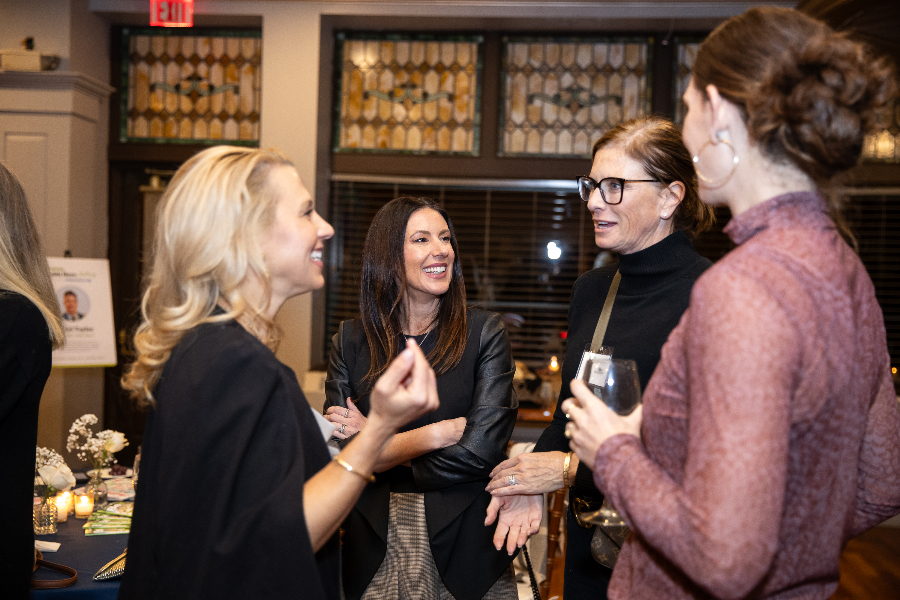
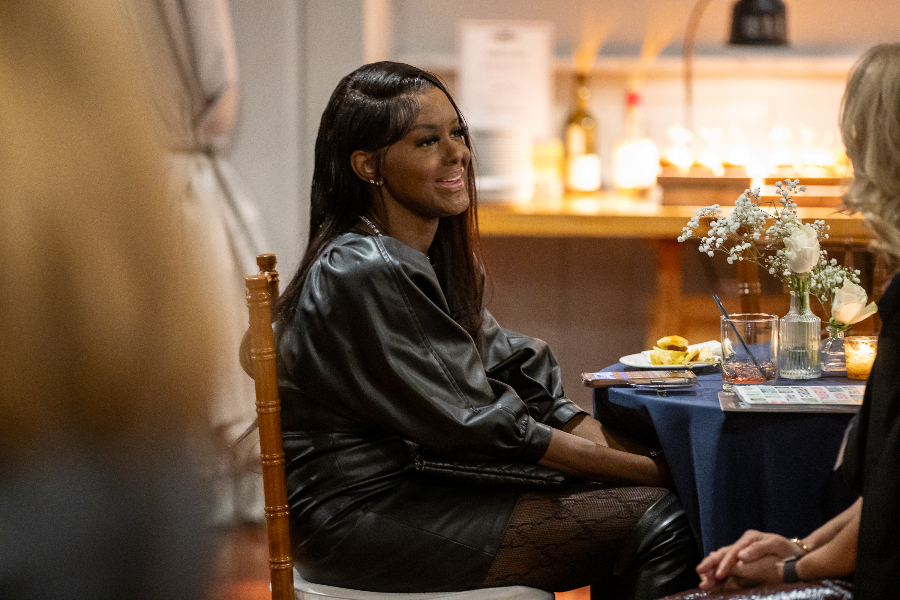
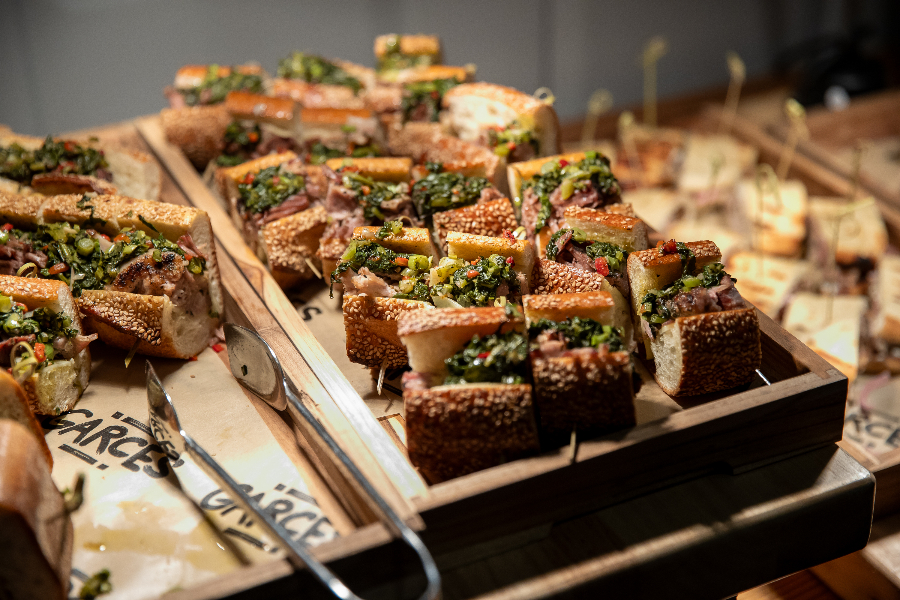
The 2024 challenge marks the 13th year of the Health Hero Challenge, which recognizes local medical professionals, frontline health workers, nonprofit leaders, teachers, coaches, entrepreneurs, and community activists who are working to improve health outcomes and general wellness for those living in and around Philadelphia.
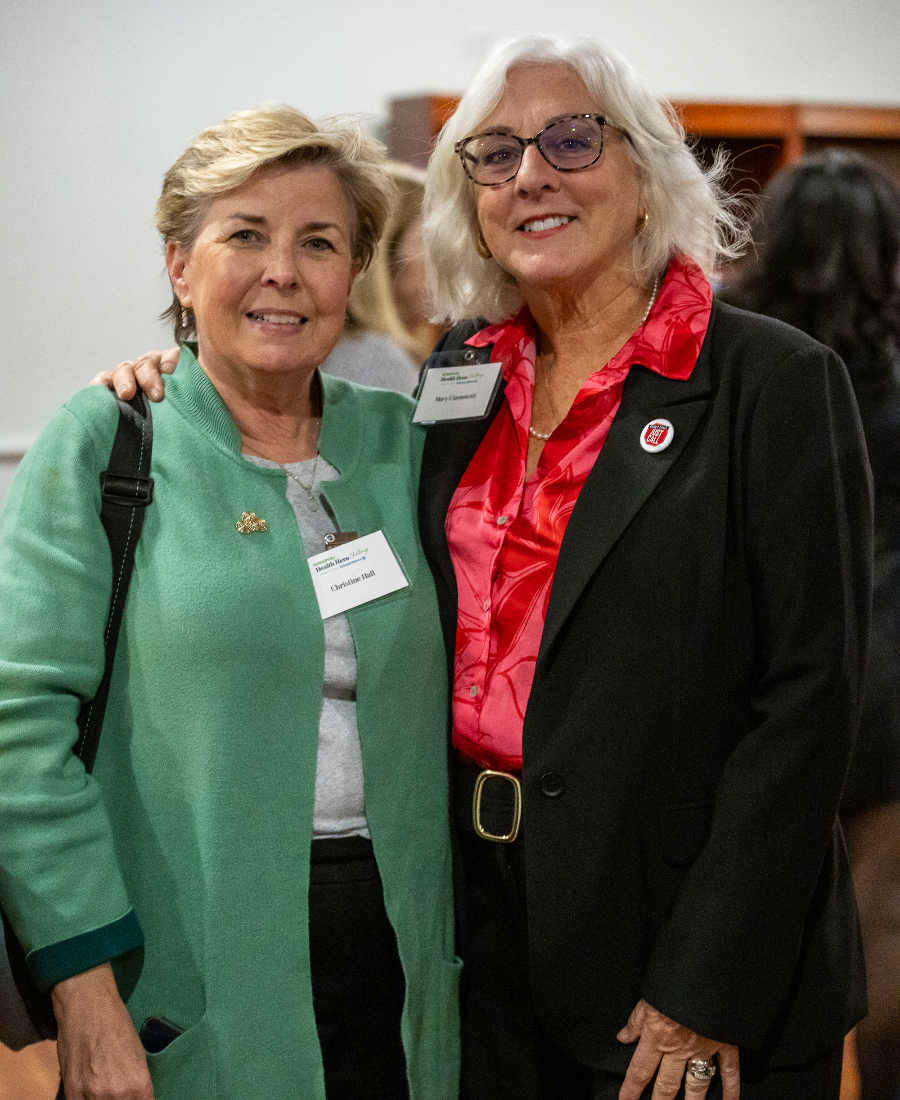
During Wednesday evening’s event, we heard remarks from Koleen Cavanaugh, senior vice president and chief marketing officer at Independence Blue Cross; Katie Bruno, the publisher of Philadelphia magazine; and Laura Brzyski (me!), health and wellness editor of Philadelphia magazine.

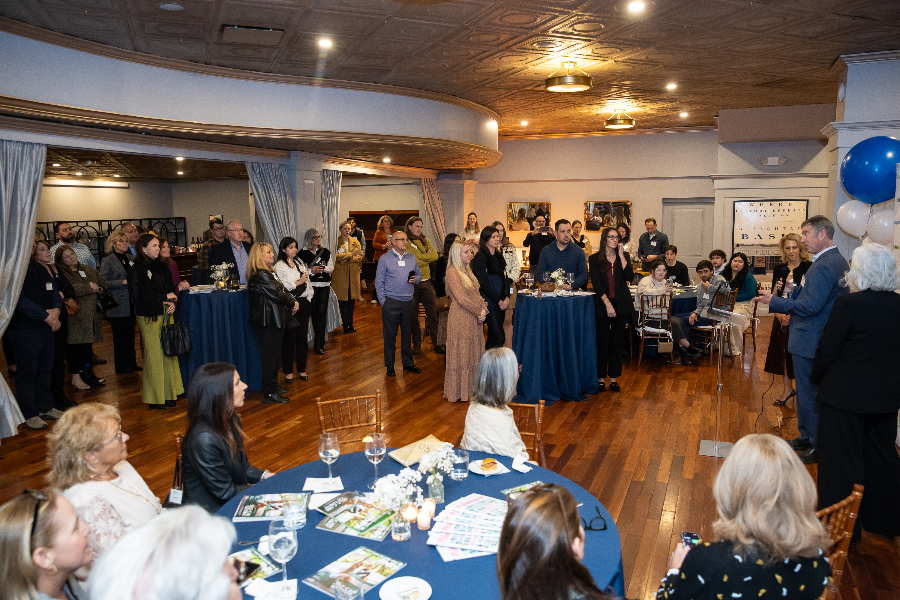
And then, after all the anticipation, we were thrilled to finally announce the 2024 Be Well Philly Health Hero: Daniel Taylor, a pediatrician at St. Christopher’s Hospital for Children. As this year’s winner, Taylor received a $15,000 donation to his charity of choice, Reach Out and Read. The nonprofit — which Taylor co-directs — promotes early literacy and school readiness by integrating children’s books into pediatric care. At every well visit, kids receive brand-new developmentally appropriate and culturally relevant books.
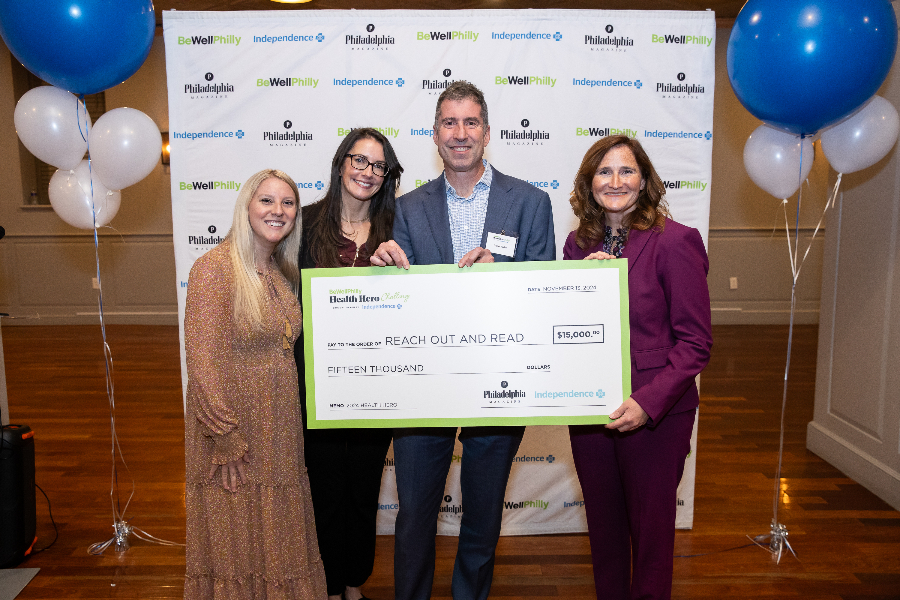
Our two runners-up — Amy Carolla, founder of Balance, a fitness center in Chestnut Hill, and the co-founder of B Inspired, and Mary Ciammetti, founder and president of Don’t Stall, Just Call — each received $2,500 for their selected charities, B Inspired and Don’t Stall, Just Call, respectively.
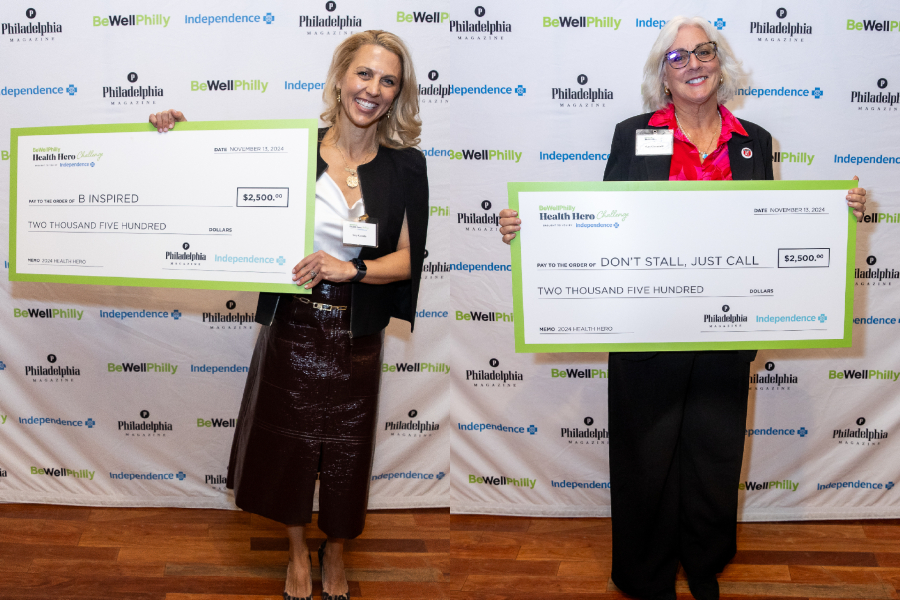
Thank you to all the individuals who were nominated for this year’s Be Well Philly Health Hero Challenge presented by Independence Blue Cross, especially the 10 semi-finalists; two runners-up, Amy Carolla and Mary Ciammetti; and our winner, Daniel Taylor.
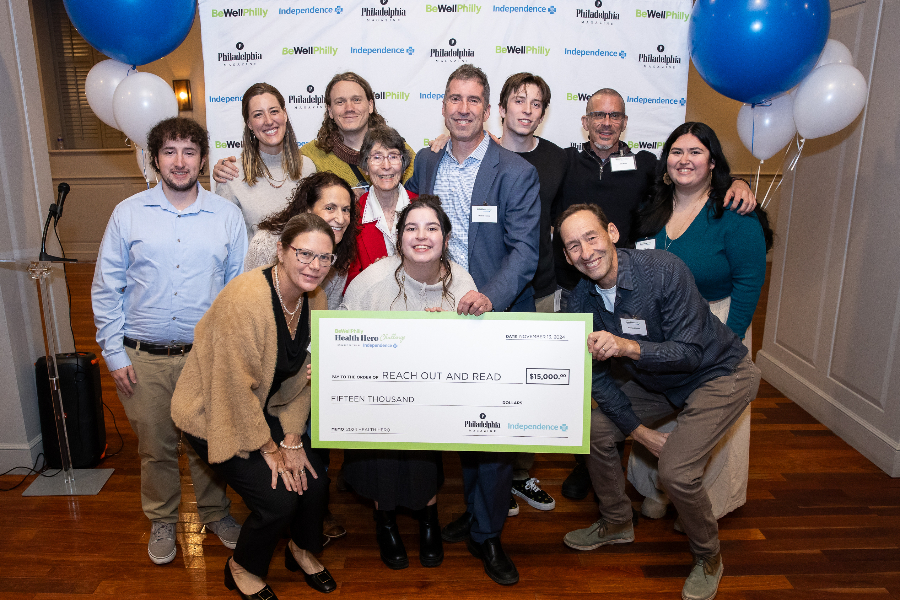
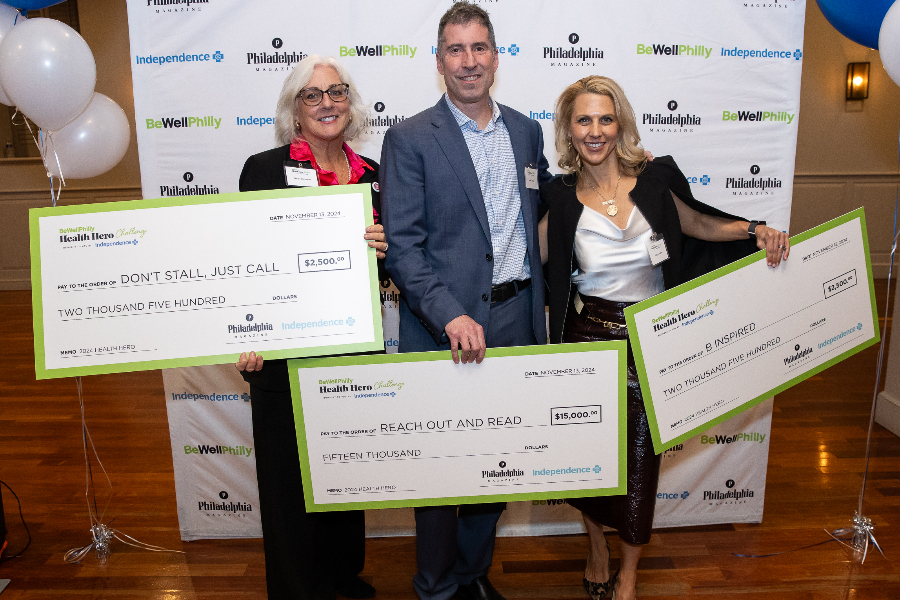
We’d also like to thank The Olde Bar for hosting us, and our presenting sponsor, Independence Blue Cross, who continues to make this program happen year after year. And to our incredible Be Well Philly community, we appreciate your participation and your support of health heroes everywhere!
You Can Barter for Thanksgiving Dinner at This South Philly Restaurant

Turkey is, of course, one of the menu items at Jennifer Zavala’s Juana Tamale, the South Philadelphia restaurant that lets you barter for Thanksgiving dinner. (Stock photo/Getty Images)
We’ve told you where to go if you want to drop lots of money on a sit-down Thanksgiving dinner inside a restaurant. And we’ve told you where you can get a whole deep-fried bird to go or spend $250 on a takeout package that replaces a turkey with a rotisserie chicken. (The horror!) But now we have a new one for you: a South Philly restaurant that lets you barter for Thanksgiving dinner.
The restaurant in question is Juana Tamale, culinary home of storied chef Jennifer Zavala. (See: vegan meatball controversy; illegal tamale truck; rescuer of Dollar Dog Night; and an interview a lot of people had thoughts about. Like we said, storied.)
On Thursday, November 28th, a.k.a. Thanksgiving, Juana Tamale is hosting a Thanksgiving party complete with free beer (while supplies last), the NFL games on the TV, and $15-per-plate platters that, yes, you can barter for.
“A lot of people are broke,” Zavala observes. “A lot of people would just be sitting alone in their apartments on Thanksgiving. I want them all to come out and chill with us.”
Zavala says she’s been interested in the bartering economy since the early days of COVID, when she saw a woman make a post in a neighborhood social media group. The woman desperately needed to print an important document but had no printer. What she did have? “She said she makes really good cakes,” Zavala recalls. And so, the woman found a cake-loving person who not only offered to print the document for her. Zavala says the person actually gave her a spare printer in exchange for the cake. And Zavala soon started bartering her acclaimed tamales in exchange for this and that. N-95 masks. Ammo. (Yes, ammo.) You name it.
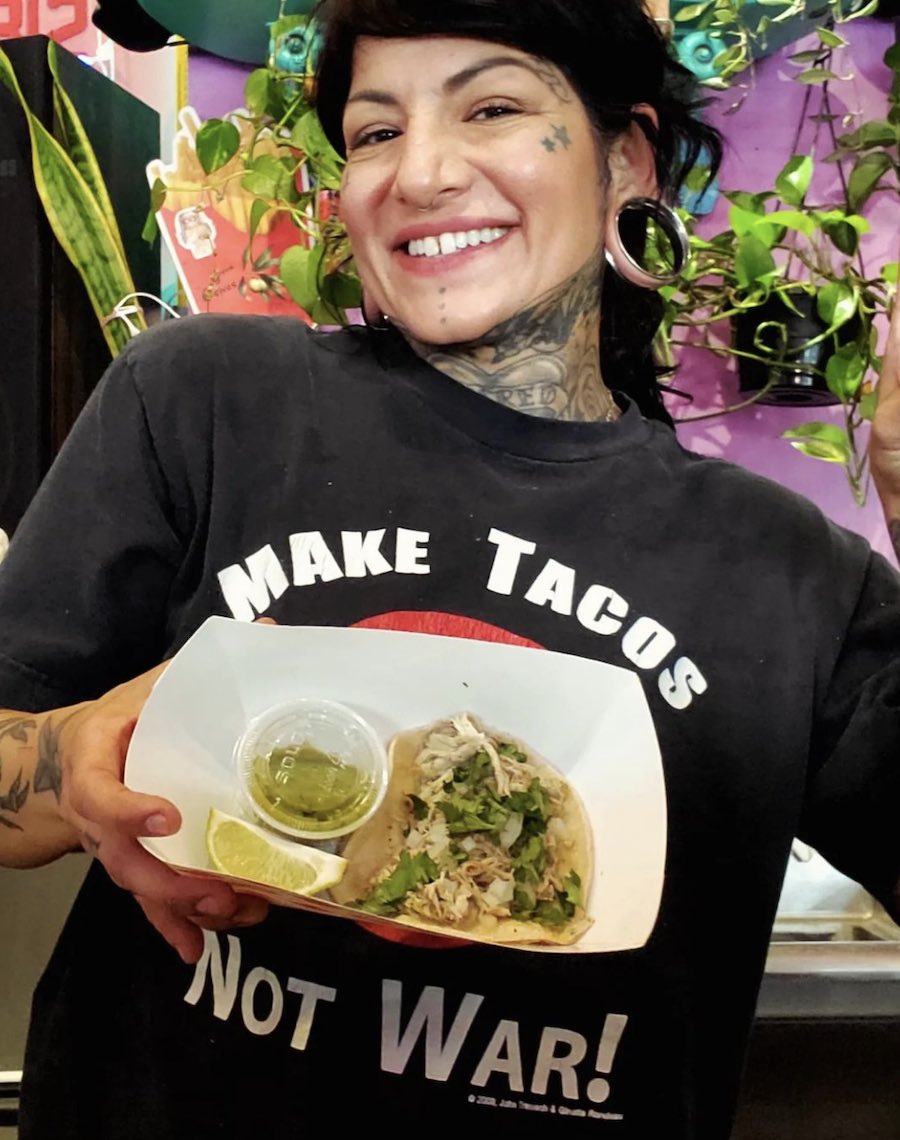
Juana Tamale owner Jennifer Zavala in South Philadelphia
You have two options at Juana Tamale on Thanksgiving. The first, she’s calling the Mayflower Platter, which includes the things you’d expect it to include. And then there’s the Plato du Juarez, a heaping plate of beans, rice, tamales, macaroni salad, salsa, and tortillas.
Zavala says she’ll accept trades of equal value to the $15 and seems fairly open-minded about what you might offer her to barter.
“Can I give you this cool old lamp I have in my basement?” I asked her.
“I actually love lamps,” she told me.
“What if my son cooks you a bunch of pizzelles using his great-grandmother’s recipe?” I offered.
“Absolutely,” she insisted.
Neighbors Grapple With Swastika Flag in Philly Burbs

A municipal sign for Philadelphia suburb Whitpain Township, where a swastika flag has been on display (photo via Whitpain Township)
Check phillymag.com each morning Monday through Thursday for the latest edition of Philly Today. And if you have a news tip for our hardworking Philly Mag reporters, please direct it here. You can also use that form to send us reader mail. We love reader mail!
Resident Flies a Swastika Flag In Whitpain Township Outside of Philadelphia
Whitpain Township is a small and generally pretty quiet suburb of Philadelphia, not often the center of controversy or in the news for bad things. But that all changed over the weekend when a Whitpain Township resident flew a swastika flag outside their home. The incident perhaps not coincidentally coincided with the anniversary of Nazi Germany’s terrifying Kristallnacht.
“We’re all horrified by this,” one Whitpain Township resident told me, requesting to remain anonymous out of concern for his family’s safety.
Residents have filed complaints with the Whitpain Township Police Department as well as with the town’s elected officials. Alas, there’s not much anyone can do about the display of the swastika flag.
“It’s in horrible taste, to say the least,” Whitpain Township police sergeant Jonathan Gallagher, who is in charge of community relations, told me on Thursday morning. “Some information was put out there — not by us — about the location of the house with the flag, and now we have to protect that person as much as we don’t agree with the flag. We have to protect them and their First Amendment rights. At this point, this is not a criminal matter, and we are just trying to keep the peace.”
Gallagher says that the department has not spoken with the resident of the home.
The Whitpain Township Board of Supervisors released the following statement:
The Whitpain Township Board of Supervisors has been made aware of the recent display of a Nazi flag in the Township. Both collectively and as individuals, we find this demonstration abhorrent, shocking, and offensive. There is no excuse nor any explanation for flying this flag. Full stop. That flag was and remains contrary to all that we believe in and all that our Township represents. Now, as established by the Supreme Court of the United States, we recognize this display is protected free speech under the First Amendment. Accordingly, while Whitpain Township is prohibited from and will not be taking any action toward the display, as individuals who live here, we condemn it in the strongest possible terms. We will not be silent in the face of evil. We trust our community will join us.
Some residents have begun to display “Hate Has No Home Here” signs. And there’s a demonstration planned for this Sunday at 3:30 p.m. outside the Blue Bell branch of the Wissahickon Valley Public Library.
Speaking of Nazis…
Last week, I told you about a bizarre “festival” I recently attended in the Poconos, a festival run by a gun-worshipping MAGA church that happens to be presided over by the son of Moonies founder Sun Myung Moon. There were lots of speakers at the festival. Lots of wing nuts and conspiracy theorists and a pastor wearing a crown of sniper bullets on his head. What I didn’t know at the time was that Donald Trump was going to be the next President of the United States and what I certainly never could have predicted was that one of the speakers at the festival was going to be tapped by Trump to be his “border czar.” What could possibly go wrong?
Johnny Doc for Secretary of Energy?
I’m kidding, of course. But with this strange list of Trump nominees that even has some Republican leaders alarmed, who’s to know? Wilson Goode to head FEMA?
By the Numbers
2: Terrifying roller coasters being retired by New Jersey’s Six Flags Great Adventure. The chopping block includes Kingda Ka — the tallest and fastest roller coaster in the world — which took riders up higher than the PECO building. I say good riddance!
$230: Current retail cost of the ChompSaw, a safe-for-kids tool whose inventors are Penn alums appearing with the tool on Shark Tank this Friday.
46 degrees: Forecasted temperature for kickoff time at the Linc tonight for the Eagles vs. Commanders game. Sometimes a stool at the neighborhood bar just seems like a better idea.
Ode to the Citywide, Philly’s Working-Class Elixir

Philly’s ever-enduring Citywide special / Photograph by Ed Newton
A shot and a beer, that’s all it is. A shot and a beer.
You can get a shot and a beer literally anywhere that serves shots and beers. Ask any bartender and they’ll set ’em up, side by side, and charge you whatever the market will bear. And you’ll drink them — first one, then the other — and you’ll think nothing at all of it.
Except in Philly.
Here, it’s not just a shot and a beer. It’s a Citywide. It’s “the Special” if you’re ordering it at Bob & Barbara’s, the place where it was (arguably, probably, almost definitely) invented. A PBR and a shot of Jim Beam, originally called “the Happy Meal,” for $3. (Today, the Special is $5.)
That’s where I had my first one, April of 2011. A friend took me — pregaming for an event farther down South Street — and I remember it because it moved me. I’d been in Philly two weeks then, maybe three, and I was nervous. Yellow-duckling new. I knew hardly anyone or anything. But we sat at the bar and he ordered and the beers and the shots came and he said, “Citywide.”
“City what?”
“Citywide,” he repeated. “Citywide Special. That’s what it’s called.”
It’s a blue-collar drink for a blue-collar town. Not a loss leader or a ploy, but an honest deal: cheap and a little bit grimy, but effective.”
It was the name that got me. The word, because I’ve always been a sucker for words. Citywide — a thing that was everywhere, that everyone knew about. A drink (two drinks) that you could ask for anyplace, and no matter who you are or where you were, they’d know what you were talking about. A shot and a beer. But also, somehow, more than just that. And I thought to myself, A city that would have something like that — its own drink, so simple and stupid and good? That’s somewhere I can live.
Other cities have their own drinks, official or unofficial. The Manhattan, New Orleans’s Sazerac, Seattle’s Last Word, whatever. Except they’re all complicated or corporatized, brand-forward or slick like a convention center brochure. But the Citywide? That’s a blue-collar drink for a blue-collar town. Not a loss leader or a ploy, but an honest deal: cheap and a little bit grimy, but effective.
The Citywide is Philly’s automatic happy hour — one that’s good all hours and in more places than you can count. It comes in many forms (a can of Hamm’s and a shot of Kamikaze at Dirty Frank’s, Tecate and tequila at La Chinesca, the Classy at Fergie’s with its shot of Paddy’s Irish Whiskey and a Narragansett), but they’ve all got the same gruff heart to them, the same leveling effect, the same equalizing power. They’re everyone’s special, Philly’s answer to every too-long day or too-short night, and they all say the same thing: Life’s fucking tough, but don’t worry. This’ll make it just a little bit better.
Published as “It’s Always Happy Hour Somewhere” in the November 2024 issue of Philadelphia magazine.
Free Drinks and Insider Secrets: How to Become a Regular at a Philly Bar
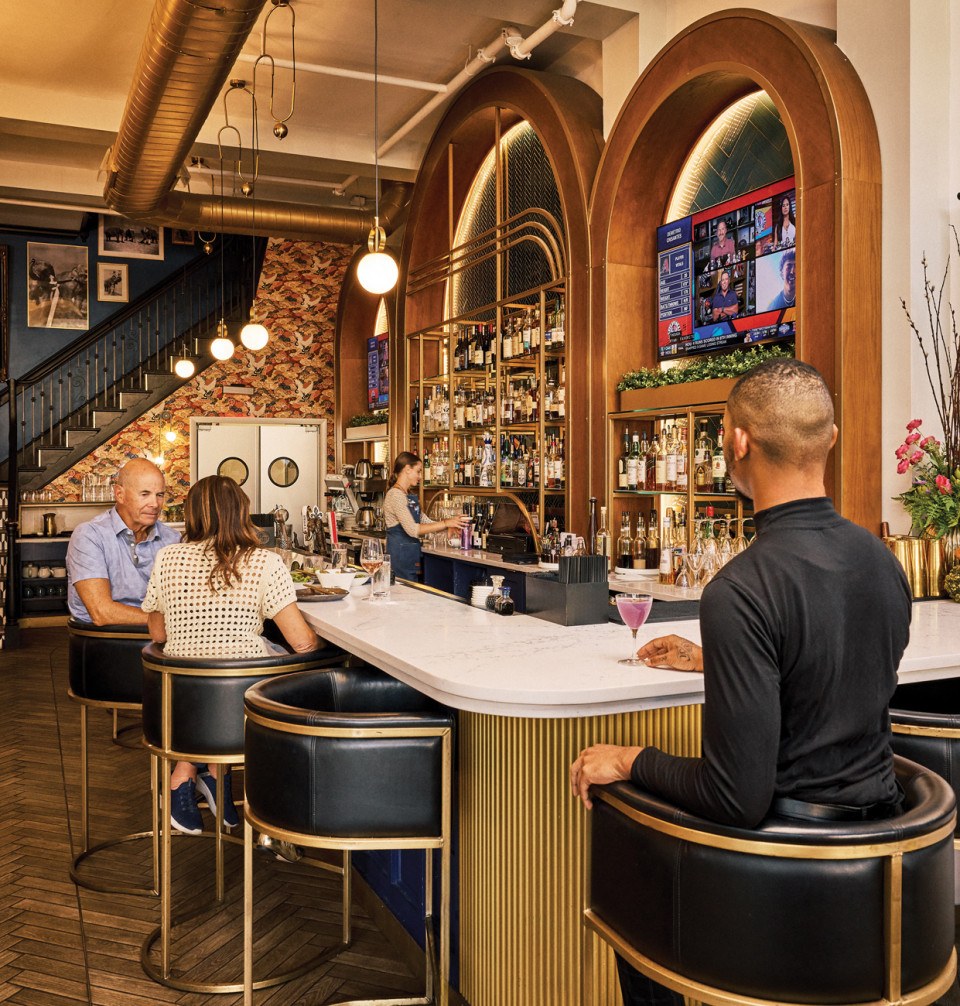
The bar at The Blue Elephant / Photograph by Ed Newton
We all want to go where everybody knows our name, right? We want to walk in and be greeted by our favorite bartender, immediately take a seat at our favorite bar stool, and have our usual served without even asking for it. There’s a certain kind of power that comes with being a bar regular. But earning that flex takes time and requires you to follow a few unspoken rules.
“[Being] a day-one supporter of the establishment will always get you pretty far,” says Brandon Thrash, general manager at Middle Child Clubhouse. But showing up for a cocktail and a roe-topped latke on opening day doesn’t make you a regular. Frequency is key. Thrash recommends weekly visits to maintain your bar cred. “Most importantly, you need to be endeared to the staff. Not just the bartenders, but everyone,” he adds.
A great way to start building rapport is to embrace the dealer’s choice — be curious and let the bartender riff on a drink tailored to your taste. Not only is it a great conversation starter, but it also signals respect for the bartender’s expertise and craft, and shows a level of confidence and trust. “Walk in with an open mind and be ready to allow the person behind that bar to take care of you and be creative,” says Randall Greenleaf, a bartender at Southwark. “You’ll get a way better experience on your end too, because you get a completely brand-new cocktail built especially for you, one that is more aligned with your palate.”
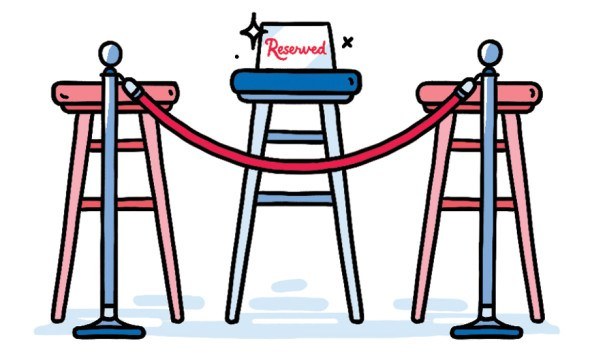
Illustration by Kati Lacker
You’ll know you’re ascending the ranks when you get a “bartender’s handshake,” a free shot usually given to industry peers but sometimes given to regulars. If the bartender digs you enough, you may be asked to hand-deliver a “boomerang” to another bar team in the area. Typically, a boomerang is a mixed drink with a note that’s sent with a guest heading over to another bar. While the legality of this is debatable, boomerangs are how industry folk show love to good guests and fellow bartenders.
“If you tell me you’re going to get a nightcap at Franklin Mortgage or a.bar or My Loup, I’ll send you off with a Pornstar Daiquiri or Lawless Doings to say hello to my good friends in the neighborhood,” says Rob Scott, a bartender at the Ranstead Room and head bartender at the soon-to-open Almanac.
Earning that coveted status of becoming a regular is more than being a frequent patron. You have to be a positive addition to the bar’s overall culture: Treat others how you would like to be treated. Be consistently genuine, friendly, and easy to talk to, and take the time to build relationships with bar staff. And always tip at least 20 percent.
Published as “Save Me a Seat!” in the November 2024 issue of Philadelphia magazine.
A Look at Bario Neal and the Rittenhouse Hotel’s Jewelry Collab
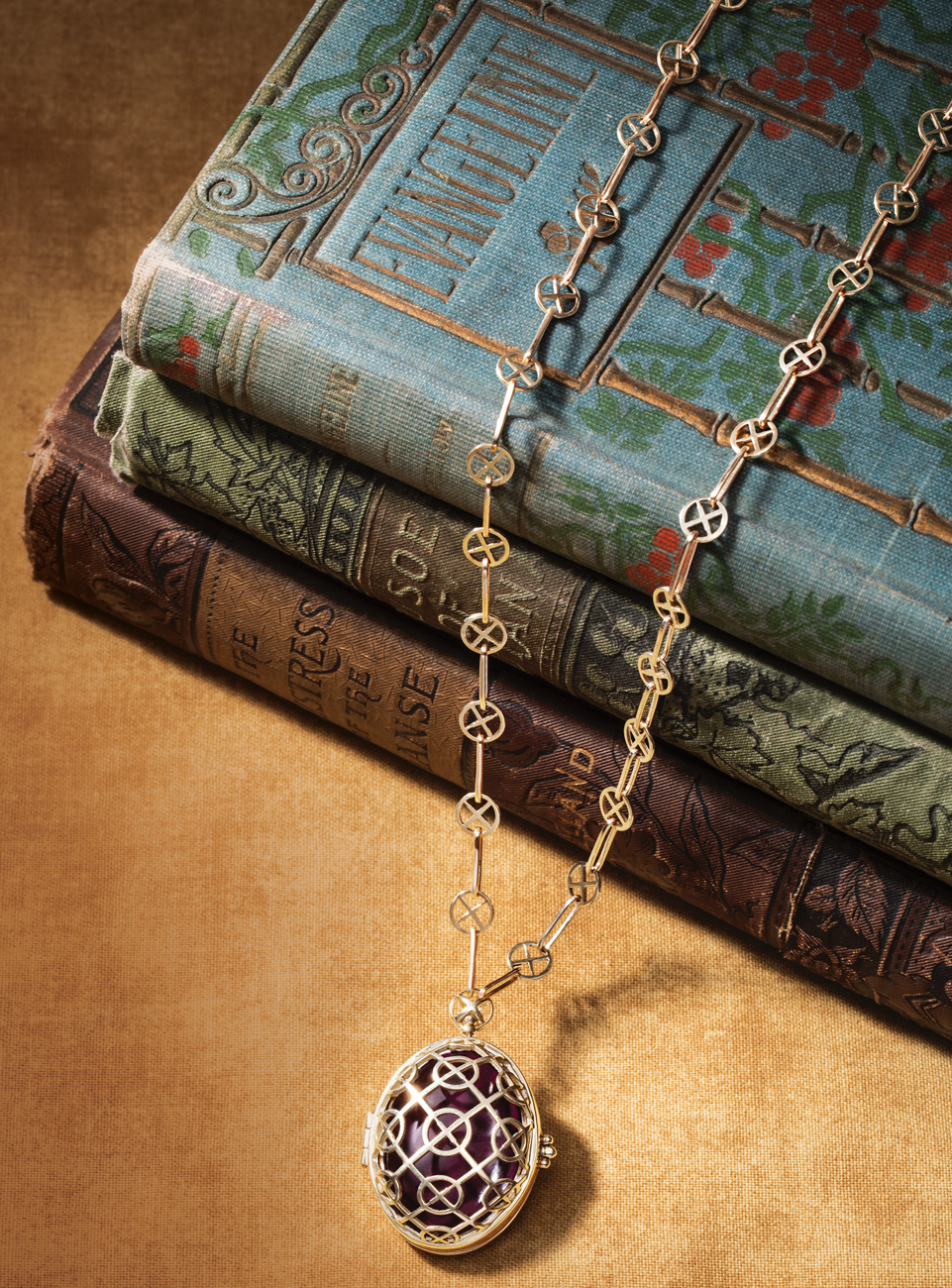
Bario Neal worked with the Rittenhouse Hotel on this locket. / Photograph by Nell Hoving Dixon
The team at Queen Village jeweler Bario Neal had always wanted to handcraft a locket but needed a reason to commit to the tricky process of designing the hinge and locking mechanism. That reason? The Rittenhouse Hotel’s 35th anniversary.
The resulting piece draws on the destination’s Rittenhouse Square-inspired logo, with diamonds on the back, a gold case, and a hand-fabricated chain — all made from recycled materials. The glass enamelwork is by local artist Joan Strott Alvini. “The locket communicates a vintage aesthetic you don’t see people make much anymore,” says Bario Neal co-owner Page Neal. The necklace is displayed in the lobby for guests to admire, but if you book the hotel’s Timeless Treasures package, you can customize your own.
The package, by the way, includes a suite at the hotel, 24-karat gold-leafed macarons, a dining experience at Best of Philly-winning Lacroix, transportation to Bario Neal, a spa treatment, and, of course, your new Rittenhouse Heirloom locket. The price tag: a glittering $10,000.
Another gem to keep on your radar? Bario Neal and the hotel have launched an heirloom concierge program, so you can refashion a beloved piece of your own jewelry (such as a ring or bracelet passed down from your grandmother) or create something completely new. Feels like a holiday must-have, don’t you think?
Package from $10,000; concierge program pricing varies; 210 West Rittenhouse Square, Rittenhouse.
Published as “Clasped Together” in the November 2024 issue of Philadelphia magazine.
Happy Hour Hookups: Can You Still Pick Someone Up at a Bar?

A couple chats at the bar at Bob & Barbara’s / Photograph by Ed Newton
Let me take you back to a different era in the American Dating Experience.
On July 27, 2000, I walked into a smoke-filled Bob & Barbara’s for happy hour, immediately taking note of two comely women sitting by the jukebox. They were engaged in a lively conversation because smartphones didn’t exist and you had to, you know, talk. I said hello. They smiled and said hello back. And I went into full-blown flirtation mode with one — her name was Suzanne — at which point both women made it clear that they were together. “But you should stick around,” Suzanne told me. “My friend Suchita will be here soon, and I think you’d really like her. And she’s hot!”
Shortly thereafter, Suchita, indeed hot, arrived with some friends. I bought everybody drinks, and, well, 24 years later, Suchita and I have a house and two almost-grown kids together.
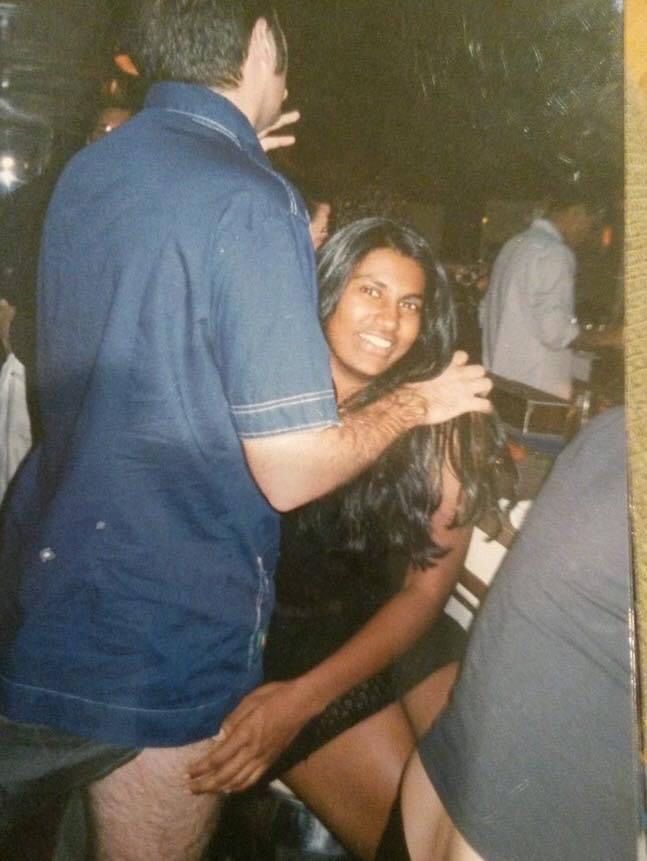
The author with his future bride at Bob & Barbara’s in 2000.
I tell this story a lot, and when people under the age of 35 hear it, they seem absolutely perplexed, unaware that it’s possible to meet people at, say, happy hour as opposed to on whatever app people are meeting each other on these days. But is it still possible?
Yes, insist Kate Catinella and Sam Stanton, the founders of the fledgling service Free Dating Advice Philly, which is exactly what it sounds like. Catinella and Stanton tell me there’s palpable “dating app fatigue” these days. Of course, one thing that prevents meeting someone new at a happy hour is that damned phone of yours, and Catinella and Stanton suggest making a conscious effort to keep your phone away — off, even.
If you’re not sure how to make an approach, the age-old method of offering to buy someone a drink is still an easy way to gauge interest. But, say Catinella and Stanton, let the bartender broker the offer.
“A woman might feel more comfortable declining through the bartender instead of directly to your face,” says Catinella. “And however you approach someone for the first time, you have to go into it willing to accept rejection and not make anyone who rejects you feel uncomfortable. Just move on.” Remember, no one is obligated to talk to you just because you’ve bought them a drink, she adds.
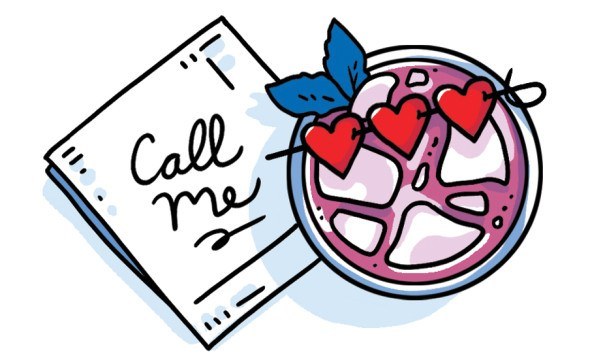
Illustration by Kati Lacker
Similarly, says Stanton, don’t ask for someone’s number, as this might exert undue pressure on the person who’s caught your eye. Instead, write down your contact information on a piece of paper and offer it up. Expect nothing. That way you can be delighted when you do get a text a few days later.
“Happy hour can really be such a great venue for meeting someone new,” says Catinella. “It’s very low stakes. But there’s still this wonderful element of discovery.”
“And it’s important to be as relaxed as possible, which will make you seem more open,” Stanton adds. “Go to a bar where you’re already comfortable. Go with a friend but not too many friends, which can seem intimidating to some people. Just go, be open, and see what happens.”
Published as “The Return of Happy Hour Hookups” in the November 2024 issue of Philadelphia magazine.
Philly Bartenders Share How to Get Served Faster
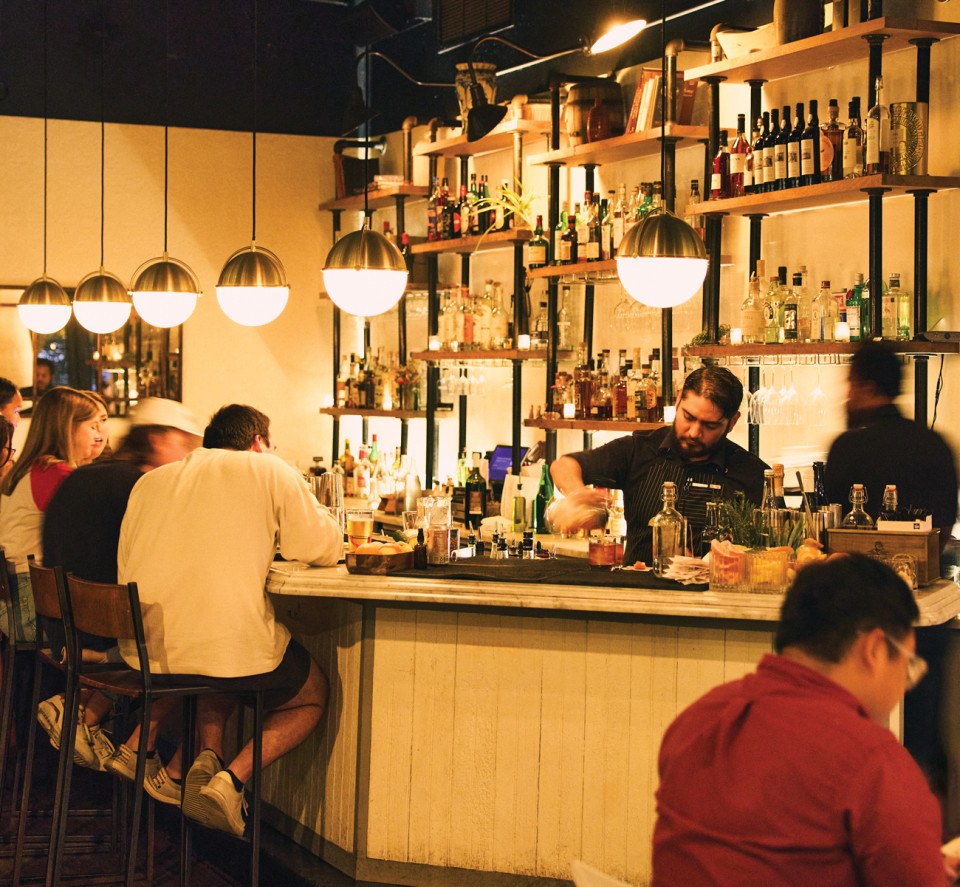
The bar at Osteria / Photograph by Ed Newton
We’ve all been there: sitting shoulder to shoulder at the bar with nothing but a wet pulpboard coaster and an empty glass in front of you. It’s time for another round, but the bar is bumping, and aside from awkward side glances, you’re not getting much attention from the very busy bartender. Do you call out? Do you wave? Do you flash some cash to show you’re ready to place an order?
“Yeah, wave your money frantically in my face. That’s really helpful,” an anonymous bartender in Center City tells me, rolling his eyes.
I asked four bartenders who work in some of the city’s busiest bars if there is some secret sauce — some trick — to getting served faster. Their responses were logical, practical, and more of a patron call to action than some quick service hack, but they all had a common thread: Don’t be a jerk. How you treat the bartender from the time you belly up to when you settle your tab sets the tone for what kind of service you’ll get that night and, if you plan on coming back, on future nights.
In Kensington, another anonymous bartender admits that if you flag her down, she might actually ignore you. “It’s a fair game,” she says. “We have a system, a flow. You will get served when it is your turn.” Turns out the same rule that applies to kindergartners eager to snag their favorite snack-time treats also applies to full-blown adults who elbow in to see who can get served first: Wait your turn.
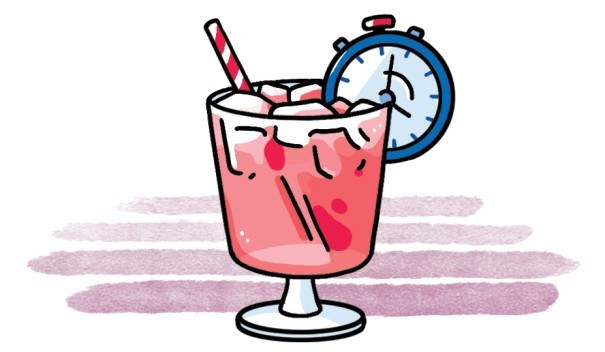
Illustration by Kati Lacker
Aside from practicing common decency, making the bartender’s job a little easier will also get you some brownie points. That same Center City bartender who just loves it when you wave your cash around says one of the most annoying things you can do to a bartender is not have your order ready to go. “Just have your shit in order, be ready when I approach,” he says. “Even if you are inquiring about a drink, that is fine. It’s what we are here for. Just be present, focused.”
Eric, a beertender at a busy brewery, runs into the same issue. He says folks will wait in line for several minutes, get to the service area, and then be absolutely clueless as to what they want. “We have signage everywhere,” he says, waving both hands at the very large, very visible menu behind him.
If you’re playing the long game and want speedy service the next time you come in, a good tip will work in your favor. “We don’t know how great the tip will be until after they close the tab, but we do remember the good ones,” an anonymous bartender in Kensington says. First impressions matter, but the last impression may decide your fate.
Published as “FastPass” in the November 2024 issue of Philadelphia magazine.
Finally, a Class-Action Lawsuit Over a Cheesesteak
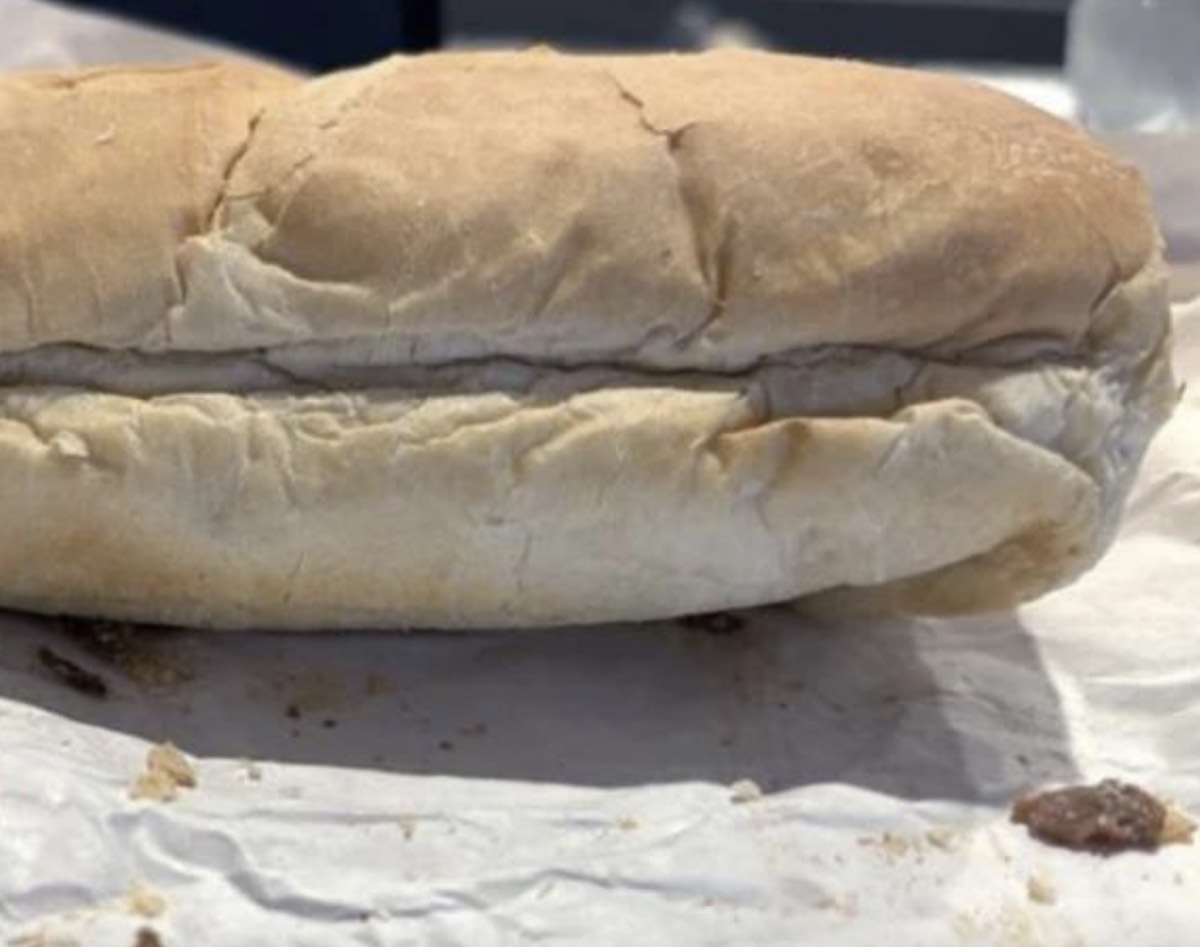
The Subway version of a cheesesteak, as seen in a lawsuit filing from federal court
Check phillymag.com each morning Monday through Thursday for the latest edition of Philly Today. And if you have a news tip for our hardworking Philly Mag reporters, please direct it here. You can also use that form to send us reader mail. We love reader mail!
Subway Slammed In Philadelphia Federal Lawsuit for Cheesesteak Abomination
I love a good lawsuit. And in the pantheon of good lawsuits, it’s hard to imagine one that’s better than a federal class action lawsuit filed over a cheesesteak. In this case, a Subway cheesesteak.
No, Subway, the multinational sandwich franchise operation, doesn’t call the sandwich at the center of this controversy a cheesesteak. They call it the Subway Steak & Cheese. But it’s chopped up steak. There’s melted cheese. So I’m just going to take the liberty of calling it a Subway cheesesteak.
The Subway Steak & Cheese is supposed to look like this:
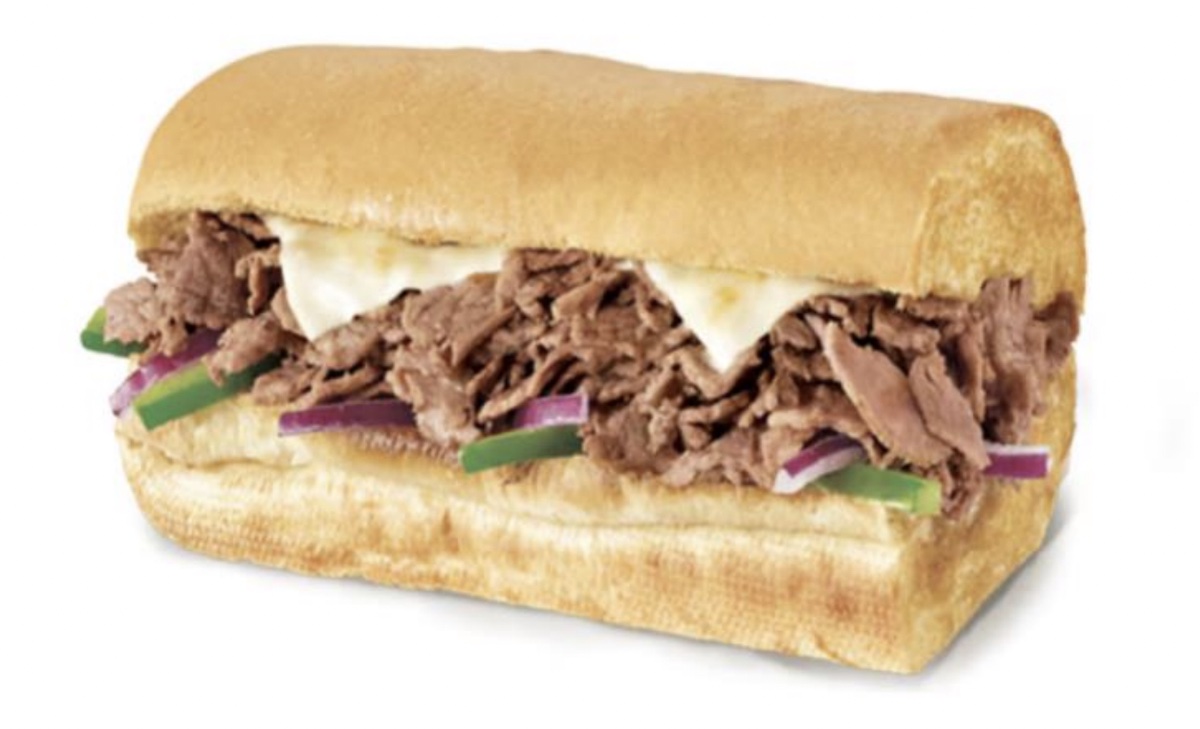
A promotional image of a Subway cheesesteak — a.k.a. the Subway Steak & Cheese — as seen in the federal lawsuit complaint.
But according to plaintiff LaGarris Montgomery, the end result actually looks like the sandwich — sorry, make that “sandwich” — at the top of this article. That’s what he claims in the federal class action lawsuit he filed in Philadelphia on Tuesday.
The lawsuit notes that Subway advertises the sandwich to contain “lots of steak” but, alleges the suit, the promotional photo depicts “at least 200 percent more meat” than the actual sandwiches. The suit calls Subway’s ads “grossly misleading” and accuses the company of deceptive advertising and unjust enrichment.
Montgomery’s lawsuit is similar to lawsuits filed by Subway customers in North Carolina and New York in recent weeks. I, for one, share in their outrage.
What Happened In McCormick vs. Casey?
Well, McCormick has claimed victory. But officials are still counting the votes. McCormick has the lead, but his lead is shrinking. And it sounds like a recount might be on the horizon.
Goodbye to Macy’s?
New remarks by Philadelphia City Councilperson Curtis Jones have people talking about the possible departure of Macy’s from Center City. This just after Giant announced it was closing its Heirloom Market in Center City. But, hey, the new Sixers arena will solve everything, right?
By the Numbers
4,000: Approximate number of challenges to mail-in ballots in Pennsylvania that have been filed. All of those challenges were either dismissed or withdrawn.
$137.5 million: Budget for Penn’s soon-to-debut newest building. It’s named after former Penn prez Amy Gutmann. Guessing Liz Magill didn’t make the cut.
$325: What a take-home Thanksgiving dinner will cost you at Lilah in Fishtown. That’s the most expensive package featured in our guide to Thanksgiving takeout meals. Meanwhile, you can get Wawa’s best sandwich — the Gobbler Shorti — for $7.59.
Local Talent
If you’re a fan of Philly chef Evan Snyder, who’s been on the pop-up circuit for a while, he finally has his own digs. He’s hoping to open Emmett in Kensington come January. And what to expect at Emmett? “Upscale grandmother” fare, he’s calling it. So, like, fruitcake but with really, really, really expensive fruits?